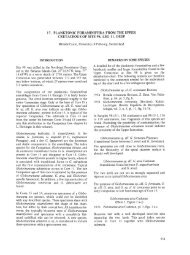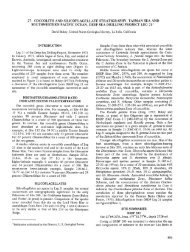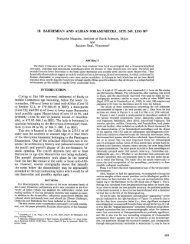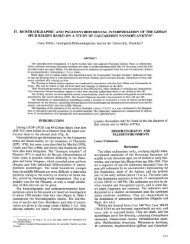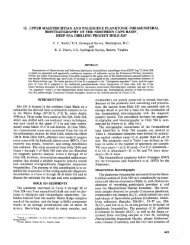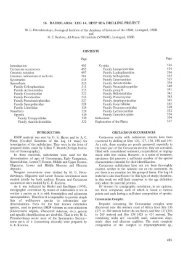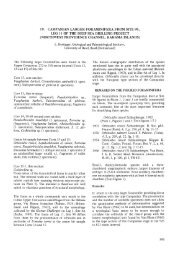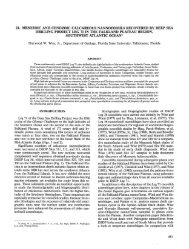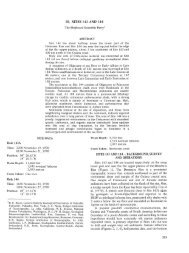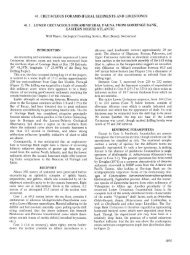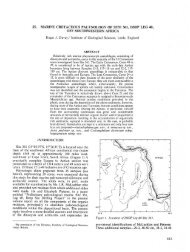1 - Deep Sea Drilling Project
1 - Deep Sea Drilling Project
1 - Deep Sea Drilling Project
Create successful ePaper yourself
Turn your PDF publications into a flip-book with our unique Google optimized e-Paper software.
y the disappearance of C. gigas diorama s.s. and C. coscinodiscus<br />
and by the earliest occurrences of H. cuneiformis,<br />
Coscinodiscus nodulifer, and Asteromphalus decorus.<br />
The base of the zone is not present in DSDP Leg 16 cores,<br />
but, as indicated by Kanaya (1971) in his discussion of the<br />
essentially equivalent Zone II in the EM cores, the last<br />
common occurrence of Coscinodiscus lewisianus provides<br />
a convenient guide, which might serve as a marker species<br />
for the next lower zonal unit. This criterion would likely<br />
be applicable to tropical areas because a single reworked^)<br />
specimen of this species was observed at DSDP<br />
158 (Plate 13, Figure 7). Assemblages from Cores 31 to 33<br />
of DSDP 158 are considered representative of this zone.<br />
Diatom Taxonomic Usage<br />
The names for diatoms in this report have been based<br />
on illustrations and descriptions in the following publications:<br />
Castracane, 1886; Cupp, 1943; Hanna, 1932; Jousé,<br />
1968; Kanaya, 1971; Kanaya and Koizumi, 1966;<br />
Koizumi, 1968; Kolbe, 1954; Lohman, 1941; Muhina,<br />
1969; Reinhold, 1937; and Wornardt, 1967.<br />
DIATOM SPECIES TABULATED<br />
Actinocyclus ehrenbergii Ralfs<br />
(Plate 8, Figures 1-2)<br />
Following the usage of Hanna (1932), forms with varying numbers<br />
of rays are included. This species occurs through the middle Miocene to<br />
upper Pliocene sections at DSDP 157 and DSDP 158. It is missing in<br />
Pleistocene samples, and in the middle Pliocene at DSDP 157, it is most<br />
common in the fine fraction.<br />
Actinocyclus ellipticus Grunow<br />
(Plate 8, Figure 3)<br />
This thick species exhibits high interference colors. It is restricted to<br />
middle Miocene cores of the Panama Basin where it is commonly a<br />
conspicuous member of the assemblages.<br />
Actinocyclus ingens Rattray<br />
(Plate 8, Figure 4)<br />
This species occurs rarely only in middle Miocene samples from the<br />
Panama Basin but is recorded as a common species in both middle and<br />
upper Miocene samples from Experimental Mohole cores about 20 degrees<br />
farther north (Kanaya, 1971).<br />
Actinoptychus senarius Ehrenberg<br />
(Plate 8, Figures 7-9)<br />
This cosmopolitan species occurs throughout the Panama Basin<br />
cores but is most common in upper Pliocene sediment at DSDP 157. It<br />
is considered a subtropical species (Lohman, 1941).<br />
Actinoptychus sp. cf. A. vulgaris monicae Grunow<br />
(Plate 8, Figure 10)<br />
Specimens referred to this twelve-compartment species generally<br />
show no areolation structures preserved, unlike those specimens illustrated<br />
by Wornardt (1967). It occurs only rarely in Pleistocene cores at<br />
DSDP 157.<br />
Actinoptychus sp. [8-section]<br />
(Plate 8, Figure 11)<br />
Alternate compartments of this form have matching substructure<br />
producing a formée-cross pattern. It is only rarely present in Pleistocene<br />
and middle Miocene samples.<br />
Arachnoidiscus ornatus Ehrenbetg<br />
(Plate 8, Figure 6)<br />
This species is recorded only rarely; most occurrences are in the<br />
middle to upper Miocene, and the specimens are fragmented.<br />
SILICOFLAGELLATE AND DIATOM STRATIGRAPHY<br />
Asterolampra marylandica Ehrenberg<br />
(Plate 9, Figures 34)<br />
Only forms composed of five sections are assigned to this species.<br />
Frustules occur intact in several samples. This species is missing at<br />
DSDP 157, in the Pliocene and Pleistocene, but occurs consistently in<br />
the middle to upper Miocene at DSDP 158. Its highest sporadic occurrence<br />
is in the upper Miocene.<br />
Asterolampra sp. [6-section]<br />
(Plate 9, Figure 5)<br />
This symmetric six-section form is the most numerous and longranging<br />
Asterolampra, occuring regularly in the middle Miocene to Pleistocene<br />
of the Panama Basin.<br />
Asterolampra sp. [7-section]<br />
(Plate 9, Figure 6)<br />
This form occurs sporadically only in the upper Miocene to upper<br />
Pliocene.<br />
Asterolampra sp. [8-section]<br />
(Plate 10, Figure 1)<br />
Eight-section varieties of Asterolampra occur only sporadically in<br />
middle Miocene to upper Pliocene cores of DSDP 157 and DSDP 158.<br />
Hendey (1937) reported it only near the equator.<br />
Asteromphalus arachne (Brebisson)<br />
(Plate 10, Figures 2-3)<br />
This small, asymmetric, five-section species is thinly constructed and<br />
has developed practically no hyaline central area. Rare sporadic occurrences<br />
are noted only in the upper Miocene to Pleistocene at DSDP 157.<br />
Asteromphalus brookei (Ehrenberg)<br />
(Plate 10, Figures 4-5)<br />
This species is intermediate between Asteromphalus heptactis and A.<br />
imbricatus, having eight to ten sections. It occurs mainly in the Pliocene<br />
section at DSDP 157.<br />
Asteromphalus decorus (Greville) n. comb.<br />
(Plate 10, Figures 6-9)<br />
Asterolampra decora Greville, 1862, Quat. Jour. Micr. Sci., n.s., v. 2, p.<br />
45, pi. 7, figs. 4-6.<br />
Asterolampra decora Greville, var. nov. Castracane, 1886, Bot. Chall.<br />
Exp., pt. 4, p. 136, pi. 16, fig. 9.<br />
This small- to medium-sized species has a complex central hyaline<br />
area more comparable to Asteromphalus than to the simple Asterolampra.<br />
It occurs sporadically through the Miocene and Pliocene sections in<br />
the Panama Basin. The circular central area shows a wide variety of<br />
complexity. Simplest forms have an inner cycle ranging from two to eight<br />
sections and have an adjacent cycle of eight to eighteen sections. More<br />
complex forms lack orderly central area cycles (see Castracane, 1886).<br />
Asteromphalus heptactis (Brebisson)<br />
(Plate 11, Figures 1-2)<br />
This species is restricted here to only seven-section forms, although<br />
eight-section forms show the same general proportions. It first occurs in<br />
the upper Miocene nannofossil Discoaster quinqueramus Zone of DSDP<br />
157 and DSDP 158 and is missing at the older EM site to the north.<br />
Asteromphalus imbricatus Wallich<br />
(Plate 11, Figures 34)<br />
This long-ranging tropical species is restricted to forms having eleven<br />
to twenty-two sections. Pleistocene and Pliocene specimens from DSDP<br />
157 tend to have subcircular central areas with a single recurved umbilical<br />
section line connecting the two appressed punctate areas (Plate 11,<br />
Figure 4). Miocene specimens from DSDP 158 have circular central<br />
areas and commonly more than one recurved umbilical section line<br />
(Plate 11, Figure 3), a character reminiscent of Castracane's (1886)<br />
illustration of "Asterolampra grevillei (Wall.) Grev., var. eximia, nov."<br />
Although occurring throughout our cores from DSDP 157 and DSDP<br />
158, this species is most abundant in the late Pleistocene.<br />
833



